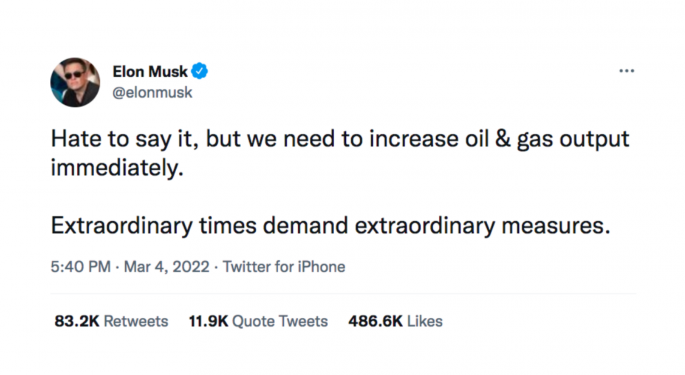When the world’s richest man Tweets, the markets listen, and Elon Musk sent shockwaves through the business world when he recently called for more oil production. The famous billionaire made much of his fortune disrupting the auto industry with electric vehicles to reduce carbon emissions, making him seem like an enemy of an oil and gas sector that made fortunes fueling gasoline-hungry cars and trucks. Perhaps Musk is not an enemy of the new, lower carbon version of the oil and gas sector. As an elite investor himself, he may be ahead of the curve on another huge investing trend – the move toward Net Zero oil and gas.
The Net Zero Oil Transformation
Musk’s remarks were a direct response to the spike in oil prices caused by the war in Ukraine. Consumers and businesses alike were sent scrambling for solutions to an energy shock that few prepared for, though energy security experts had been calling for the expansion of oil and gas pipelines and infrastructure in North America for decades. The stalled development was primarily driven by growing concerns about the carbon emissions from the sector. However, rather than lowering consumption, the delays and blockades just shifted oil production to brutal regimes with no environmental or human rights standards, while much of the heavily regulated North American industry suffered.
Despite the general public’s misunderstanding of the sector’s sustainability progress, North American oil and gas innovators have been moving steadily toward significant removal of carbon emissions from the industry, a state known as Net-Zero. Net Zero oil would address many environmentalists’ carbon emissions concerns, while protecting human rights from the dictators, making billions from the democratic West’s energy needs.
How Does Net Zero Oil Work?
By reducing carbon emissions at every stage of the lifecycle of oil and gas – from exploration to production, to consumption – oil and gas can ultimately become Net-Zero.
As an example, take RocketFrac, an energy service company with an exciting cleantech innovation that lowers the emissions produced by stimulating wells relative to alternative options.
In the energy industry, hydraulic fracturing is used to enhance the production of reservoirs, meaning much less drilling has to take place. By itself, these innovations have helped the industry lower carbon emissions. However, hydraulic fracturing is also energy-intensive, requiring hundreds of thousands or even millions of liters of water and tonnes of sand, all of which have to be sourced, treated or refined, transported and stored, all actions which contribute to generating a significant carbon footprint.
RocketFrac replaces fresh water and sand with technological ingenuity, using only 40 pounds of proprietary rocket fuel for fracturing near the well-bore in every eight-foot section of the zone being targeted. Used with RocketFrac’s patent-pending downhole tool, the rocket fuel is energized deep underground, generating shockwaves and gasses which fracture the target zone, unlocking oil and/or gas production.
“Our technology is designed to help producers with the need to improve the production characteristics of the reservoir around the well-bore, but we are taking an approach which also helps protect the environment,” notes Tom Whalen, RocketFrac’s CEO. “We are able to generate high pressures at the perforations, fracturing the target zone, similar to conventional methods, but without the consumption of fresh water and sand, and all of the carbon emissions that go along with them. For the right candidate wells, we are the ideal solution technically, while making a meaningful step toward Net Zero emissions in our portion of the industry.”
Carbon Capture, Utilization, and Storage
Reducing carbon emissions in production is a fantastic and important step – but what about at the point of consumption? When we think about oil and gas, it is the emissions from the tailpipe and smokestacks that have people the most worried.
Fortunately, there are already incredible technological solutions there as well.
The heating effect of greenhouse gasses like carbon dioxide comes from their presence in the atmosphere. There is nothing inherently bad or dangerous about carbon dioxide, but it can absorb heat from the sun when in the atmosphere, and in large enough quantities scientists say it may increase the average temperature on the earth’s surface. However, if it is not emitted into the atmosphere, this process does not occur.
Technologists have found ways to capture the carbon dioxide and other greenhouse gasses emitted from combustion and keep them out of the air by either converting them into a usable form (utilization) or by storing them safely underground.
Natural gas is one of our most important sources of heat and electricity, providing life-enhancing energy to hundreds of millions of people. When natural gas (NG) is burned to create heat or electricity, it produces greenhouse gas emissions, albeit at 60% less than the rate of coal-fired power generation. However, these carbon emissions from NG power generation, are already being captured at some sites around the world, like Canada’s Shepherd Energy Centre. At Shepherd, the captured carbon is being added to cement and other products, where it is permanently trapped and also makes the cement stronger.
Captured carbon dioxide can also be turned into pure carbon, to become the carbon fiber that is in bikes and airplane frames, and thousands of other uses. What starts as a humble hydrocarbon molecule, can become life-saving, life-improving, long-life products with no carbon emissions. With the acceleration of technology innovation, the sector could even take more carbon dioxide out of the atmosphere than is required to produce the hydrocarbon energy we need.
Elon Musk may ‘hate to say’ that the world needs more oil production, but the tech-forward businessman would have to approve of the game-changing innovations coming from RocketFrac and thousands of oil and gas innovators making the world’s Net Zero dream into reality. It is not just Tesla and Space X and Musk’s $70 million private plane that depends on oil and gas, but global agriculture that feeds the world. Since the world needs oil to survive, should Musk and all of us support the innovators trying to make it all Net Zero Oil?
© 2022 Benzinga.com. Benzinga does not provide investment advice. All rights reserved.







